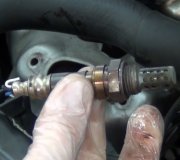If the converters good
suspect the O2 sensors and replace them all
DTCs associated with this test are DTC P0420 (Bank No. 1 or Y-pipe system), and P0430 (Bank No. 2). Because an exponentially weighted moving average algorithm is used for malfunction determination, up to 6 driving cycles may be required to illuminate MIL during normal customer driving. If KAM is reset or battery is disconnected, a malfunction will illuminate MIL in 2 drive cycles.
Description
Catalyst Efficiency Monitor uses an oxygen sensor before and after catalyst to infer hydrocarbon efficiency based on oxygen storage capacity of catalyst. Under normal, closed-loop fuel conditions, high efficiency catalysts have significant oxygen storage. This makes switching frequency of rear Heated Oxygen Sensor (HO2S) very slow and reduces amplitude of those switches as compared to switching frequency and amplitude of front HO2S. As catalyst efficiency deteriorates due to thermal and/or chemical deterioration, its ability to store oxygen declines. Post-catalyst or downstream HO2S signal begins to switch more rapidly with increasing amplitude, approaching switching frequency and amplitude of pre-catalyst or upstream HO2S.
NOTE: The predominant failure mode for high mileage catalysts is chemical deterioration (phosphorus deposition on front brick of catalyst), not thermal deterioration.
All vehicles utilize a Federal Test Procedure (FTP) based catalyst monitor. Meaning catalyst monitor must run during a standard FTP emission test. This differs from a 20 second steady state catalyst monitor used in 1994-96 vehicles. Currently, 2 slightly different versions of catalyst monitor are utilized; Switch Ratio Method and Index Ratio Method. Beginning with 2001 model year, both versions will continue to be used in subsequent model years.
Need a tool or a tester CHECK IT @
need manual CHECK IT @
https://www.2carpros.com/kpages/auto_repair_manuals.htm
Wednesday, November 12th, 2008 AT 8:22 PM


